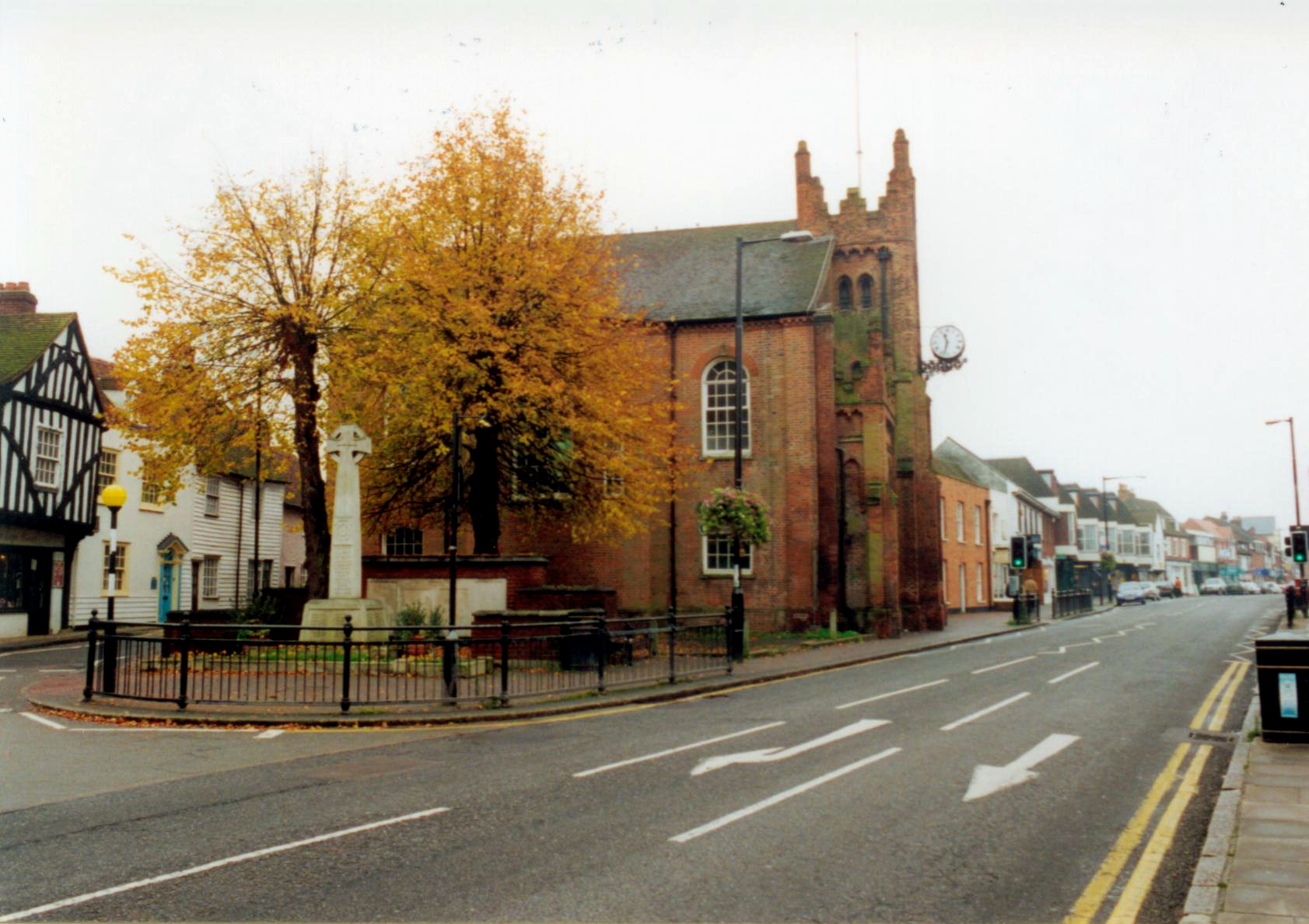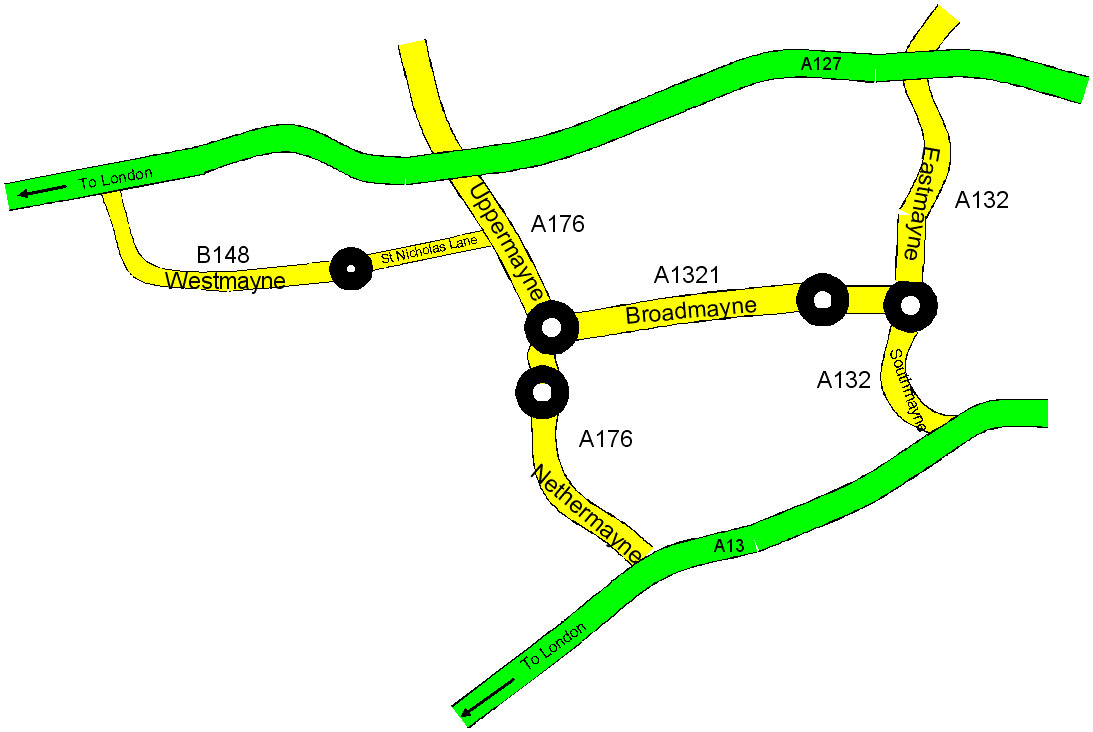|
Noak Bridge
Noak Bridge is a housing estate in the civil parish of Laindon in Basildon, Essex. The estate takes its name from the bridge over the River Crouch at the foot of nearby Noak Hill. Prior to its development most of the area was secondary woodland that had developed on the site of previous plotlands known as 'Central Park'. The continued use of South African street names in part of the area reflects the street names in the previous development. When people first moved into Noak Bridge the area was often popularly referred to as 'Wash Road', or the 'Wash Road Estate' after the road on its northern boundary, which in turn took its name from the 'wash' or ford that has now been replaced by a bridge just before the road's junction with Harding Elms Road. Part of that secondary woodland survives as Noak Bridge Nature Reserve. Noak Bridge is a rare example of a post-war, social housing estate that has been designated a Conservation Are First planned in the 1970s as part of Basildon new to ... [...More Info...] [...Related Items...] OR: [Wikipedia] [Google] [Baidu] |
Basildon (district)
The Borough of Basildon is a local government district in south Essex in the East of England, centred on the town of Basildon. It was formed as the Basildon District on 1 April 1974 from the former area of Basildon Urban District and the part of Thurrock Urban District that was within the Basildon New Town. The population of the district as of 2010 is about 172,000. The local authority is Basildon Borough Council. The council made an application for borough status in February 2010 and this was given approval that year, with Mo Larkin becoming the first mayor in October. History The Basildon District was created on 1 April 1974 as part of the local government reorganisation of the Local Government Act 1972. It comprised the former area of the Basildon Urban District and the part of Basildon New Town that had been in Thurrock Urban District. Governance Elections to Basildon Borough Council are held in three out of every four years, with one third of the 42 seats on the counci ... [...More Info...] [...Related Items...] OR: [Wikipedia] [Google] [Baidu] |
Essex
Essex () is a county in the East of England. One of the home counties, it borders Suffolk and Cambridgeshire to the north, the North Sea to the east, Hertfordshire to the west, Kent across the estuary of the River Thames to the south, and Greater London to the south and south-west. There are three cities in Essex: Southend, Colchester and Chelmsford, in order of population. For the purposes of government statistics, Essex is placed in the East of England region. There are four definitions of the extent of Essex, the widest being the ancient county. Next, the largest is the former postal county, followed by the ceremonial county, with the smallest being the administrative county—the area administered by the County Council, which excludes the two unitary authorities of Thurrock and Southend-on-Sea. The ceremonial county occupies the eastern part of what was, during the Early Middle Ages, the Anglo-Saxon Kingdom of Essex. As well as rural areas and urban areas, it forms ... [...More Info...] [...Related Items...] OR: [Wikipedia] [Google] [Baidu] |
Billericay (constituency)
Billericay was a constituency represented in the House of Commons of the Parliament of the United Kingdom. It elected one Member of Parliament (MP) by the first past the post system of election. It returned Conservative MPs at every election except 1966. History The seat was first created as a county constituency for the 1950 general election under the Representation of the People Act 1948, as a successor to the abolished seat of South East Essex. The First Periodic Review of Westminster constituencies brought in for the 1955 general election resulted in major boundary changes and it was abolished by the Second Review for the February 1974 general election. It was re-established for the 1983 general election, with further major changes for the 1997 general election, and abolished once again for the 2010 general election. Boundaries and boundary changes 1950–1955: The Urban Districts of Billericay, Benfleet, Canvey Island, and Rayleigh. Formed from the abolished ... [...More Info...] [...Related Items...] OR: [Wikipedia] [Google] [Baidu] |
Civil Parish
In England, a civil parish is a type of administrative parish used for local government. It is a territorial designation which is the lowest tier of local government below districts and counties, or their combined form, the unitary authority. Civil parishes can trace their origin to the ancient system of ecclesiastical parishes, which historically played a role in both secular and religious administration. Civil and religious parishes were formally differentiated in the 19th century and are now entirely separate. Civil parishes in their modern form came into being through the Local Government Act 1894, which established elected parish councils to take on the secular functions of the parish vestry. A civil parish can range in size from a sparsely populated rural area with fewer than a hundred inhabitants, to a large town with a population in the tens of thousands. This scope is similar to that of municipalities in Continental Europe, such as the communes of France. However, ... [...More Info...] [...Related Items...] OR: [Wikipedia] [Google] [Baidu] |
Laindon
Laindon is a commuter town in Essex, between Basildon and West Horndon. It was an ancient parish in Essex, England, that was abolished for civil purposes in 1937. It was based on the (probably smaller) manor of the same name and now lies mostly within the urban area of Basildon. As of 2020, Laindon's population was 37,175. History The ancient Laindon parish included the chapelry of Basildon that became a civil parish in its own right in 1866. The parish included two detached pieces of coastal grazing land, one of which was on Canvey Island. It included a long finger of land north into the neighbouring parish of Great Burstead to include Laindon Common and the once larger and adjacent Frith Wood which the lord of the manor, the Bishop of London, emparked around 1260. This finger of land may have been the territory of Well Street Manor, which was mentioned in the Domesday Book. Until its abolition in 1937, there was a Laindon parish. It incorporated 412 residents around , in 1831 ... [...More Info...] [...Related Items...] OR: [Wikipedia] [Google] [Baidu] |
River Crouch
The River Crouch is a small river that flows entirely through the English county of Essex. The distance of the Navigation between Holliwell Point which is north of Foulness Island and Battlesbridge is 17.5 Miles, i.e. 15.21 Nautical Miles. Route The Crouch rises in 'The Wilderness' on the Burstead Golf course at Little Burstead. The Wilderness consists of several small ponds surrounded by a tiny area of ancient woodland. The ponds date from around 1250, when they were used for the farming of fish for Stockwell Hall, and also served as a defensive moat for the hall. In the mid 16th century, the hall was moved to a new site, some to the west, and the original building was dismantled and reassembled to form the rear of the new hall. The new Stockwell Hall received a new frontage in the 18th century, and has two storeys with attics. On the east gable was a large clock with the figures made from blackened bones, but these have largely been replaced by wooden figures. Although the W ... [...More Info...] [...Related Items...] OR: [Wikipedia] [Google] [Baidu] |
Amphibians
Amphibians are four-limbed and ectothermic vertebrates of the class Amphibia. All living amphibians belong to the group Lissamphibia. They inhabit a wide variety of habitats, with most species living within terrestrial, fossorial, arboreal or freshwater aquatic ecosystems. Thus amphibians typically start out as larvae living in water, but some species have developed behavioural adaptations to bypass this. The young generally undergo metamorphosis from larva with gills to an adult air-breathing form with lungs. Amphibians use their skin as a secondary respiratory surface and some small terrestrial salamanders and frogs lack lungs and rely entirely on their skin. They are superficially similar to reptiles like lizards but, along with mammals and birds, reptiles are amniotes and do not require water bodies in which to breed. With their complex reproductive needs and permeable skins, amphibians are often ecological indicators; in recent decades there has been a dramatic decli ... [...More Info...] [...Related Items...] OR: [Wikipedia] [Google] [Baidu] |
Dragonflies
A dragonfly is a flying insect belonging to the infraorder Anisoptera below the order Odonata. About 3,000 extant species of true dragonfly are known. Most are tropical, with fewer species in temperate regions. Loss of wetland habitat threatens dragonfly populations around the world. Adult dragonflies are characterized by a pair of large, multifaceted compound eyes, two pairs of strong, transparent wings, sometimes with coloured patches, and an elongated body. Many dragonflies have brilliant iridescent or metallic colours produced by structural colouration, making them conspicuous in flight. An adult dragonfly's compound eyes have nearly 24,000 ommatidia each. Dragonflies can be mistaken for the closely related damselflies, which make up the other odonatan infraorder ( Zygoptera) and are similar in body plan though usually lighter in build; however, the wings of most dragonflies are held flat and away from the body, while damselflies hold their wings folded at rest, along ... [...More Info...] [...Related Items...] OR: [Wikipedia] [Google] [Baidu] |
Crataegus
''Crataegus'' (), commonly called hawthorn, quickthorn, thornapple, Voss, E. G. 1985. ''Michigan Flora: A guide to the identification and occurrence of the native and naturalized seed-plants of the state. Part II: Dicots (Saururaceae–Cornaceae)''. Cranbrook Institute of Science and University of Michigan Herbarium, Ann Arbor, Michigan. May-tree,Graves, Robert. ''The White Goddess: A Historical Grammar of Poetic Myth'', 1948, amended and enlarged 1966, New York: Farrar, Straus and Giroux. whitethorn, Mayflower, or hawberry, is a genus of several hundred species of shrubs and trees in the family Rosaceae, native to temperate regions of the Northern Hemisphere in Europe, Asia, North Africa, and North America. The name "hawthorn" was originally applied to the species native to northern Europe, especially the common hawthorn ''C. monogyna'', and the unmodified name is often so used in Britain and Ireland. The name is now also applied to the entire genus and to the related Asian ... [...More Info...] [...Related Items...] OR: [Wikipedia] [Google] [Baidu] |
Basildon
Basildon ( ) is the largest town in the borough of Basildon, within the county of Essex, England. It has a population of 107,123. In 1931 the parish had a population of 1159. It lies east of Central London, south of the city of Chelmsford and west of Southend-on-Sea. Nearby smaller towns include Billericay to the north-west, Wickford to the north-east and South Benfleet to the south-east. It was created as a new town after World War II in 1948, to accommodate the London population overspill from the conglomeration of four small villages, namely Pitsea, Laindon, Basildon (the most central of the four) and Vange. The local government district of Basildon, which was formed in 1974 and received borough status in 2010, encapsulates a larger area than the town itself; the two neighbouring towns of Billericay and Wickford, as well as rural villages and smaller settlements set among the surrounding countryside, fall within its borders. Basildon Town is one of the most densely populat ... [...More Info...] [...Related Items...] OR: [Wikipedia] [Google] [Baidu] |

.jpg)
.png)


